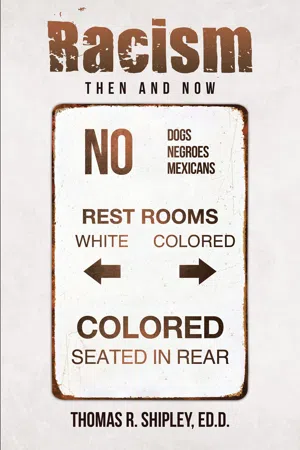![]()
Chapter 7
Institutional Racism vs. Individual Bigotry
Discrimination in the United States has been baked into our everyday was of life for many years. It didn’t matter who you were, or how well you behaved, or how hard you worked, if you were of African American descent, “the system” discriminated against you. As an example, until the middle of the 1950s, many school districts had four pay scales for their teachers. Ranging from highest to lowest were: White Men, White Women, Colored Men, and Colored Women. Similar institutional discrimination was blatant—was built in to the system via “denial.” Now, no longer subtle, easily identifiable practices were legally expressed as denial of rights, of justice, of freedom, of education, of respect, and opportunity for advancement. In some places, Jim Crow laws were still being enforced in 1965. I personally saw “White Men Only” signs still existing in 1955. (See Chapter 3: Sir)
That is Institutional Racism—not Individual Bigotry.
Resentment and frustration on the part of all African descendants was justified and understandable. How do you advance while being denied equal treatment? Denied by the system and denied by individuals. How to you succeed without a quality education? How do you “prove your value” without equal opportunity? Even worse, how do you demonstrate your dissatisfaction without being shot?
Unemployment led to poverty, and poverty begets poverty.
Science has proven that idleness and depression, fear, resentment, and anger,
inevitably produced unhealthy interactions and destructive social behavior.
That behavior boldly exacerbated the impossibility of a Black society ever
integrating into the bustling, thriving, White community.
Never forget—as previously discussed, even you—even today—avoid associating with anyone not up to “your” standards. Standards of education, housing, hygiene, behavior—all of which we will discuss.
The Time for Change
Please go with me back a few pages to revisit the practice of slavery in days long gone by. Remember that the master/slave relationship was overtly financial, but occasionally it was also covertly social. (See Chapter 1: My Bessie) There was an implied sense of inferiority, perceived only because of the color of one’s skin. Blackness was, and remains, the single variable that gets never-ending press, conversation, and coverage. Slavery was then, and is now, all about socioeconomic conditions—not skin color. As long as the conversations continue to use Blackness as the single variable, we will make no progress. No progress, because Blackness is not the problem. Only in America did skin color and slavery become irreparably connected.
Please, please, think about this:
The reason today’s bigotry is not being eliminated, is because we are only addressing the color of one’s skin as the single variable as the predominant cause of racism. Bigotry is based only on skin color; it has been learned—is not naturally instinctive.
When observing two-year-olds
grow up together in my mixed-race Child Development Center,
it was obvious that, unless bigotry was taught,
it didn’t exist.
Friendship, love, cooperation, compatibility
all bloomed naturally.
*****
Rationale
For the last hundred years, young Black people had a blatant, legitimate excuse for not advancing. Even if they were capable, they were denied opportunity. Should I be a maid or a nanny? Should be a ditch digger or stevedore? Will I ever get out of a minimum wage job? Options and opportunities were rare. Words like “riot,” “demonstration,” and “entitlement” were understandable, but until recently, rarely used. Unemployment and poverty led far too frequently to crime and violence. The few who broke through were intimidated about helping others for fear of retaliation from both camps, for fear of losing what they had accomplished.
Life was unfair, unjust, and morally corrupt.
Not to succeed needed no excuse…not succeeding was easy.
There were (past tense, “were”) many legitimate excuses for failure.
For every condition—there was an identifiable reason.
During that long period, many people were working tirelessly to stop the discrimination. Laws were, not only being implemented, but they were finally, slowly, starting to be enforced. Behaviors and beliefs were being changed, and there were cracks in the patterns of past behavior of the white establishment, and the privileges of its citizenry. Even so, the several true stories I shared with you earlier in this book, show that discrimination continued well into the 1960s, and in some parts of the nation, is still (not so subtly) happening today. Pickup trucks waving huge Rebel flags are not Halloween costumes or parlor games.
Integration of schools tried to assured equal educational opportunities. If the city schools were poor, they were poor for everyone in the city. If the county schools were better, they were better for everyone in the county, because everyone went to the same school system. The previous separate-but-equal had always been separate, but rarely equal. School integration was an attempt to make education more equal and (at least on paper,) less separate.
The problem as I see it
In the beginning, the Black schools were staffed by Black teachers, most of whom (because of their age when they were in teacher training) had been educated in substandard, all-Black institutions themselves. This perpetuated the less than stellar performance of the early Black schools. The errant social acceptance of poor articulation and incorrect pronunciation, coupled with less qualified staff and very little home support from poorly educated parents, provided the young Black student very inadequate role models to emulate, or guidance and support toward successful integration into a predominantly White culture.
As agricultural jobs became less available, and city opportunities grew. An elementary observation of the situation will show that overwhelming numbers of Black folks migrated to cities seeking work. Because of the new integration legislation, they attended the same inner-city public schools as everyone else. Tha...
